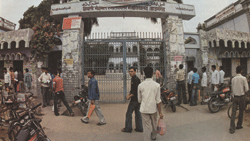Azamgarh, a small district town in Uttar Pradesh, some 300 km from the state capital Lucknow, is trapped in the glare of an uncomfortable national spotlight ever since a number of youth from the town, most of them students, were arrested six weeks ago in Delhi on terrorism charges. Once home to greats such as poet Kaifi Azmi, scholar Rahul Sanskritayan and educationist Maulana Shibli Nomani, Azamgarh’s nightmare began in the early morning hours of September 19 in distant Delhi when a hail of police bullets rained on L18 Batla House, Jamia Nagar, New Delhi and cut down Atif Amin (24) and Mohammed Sajid (16). According to the Delhi police, they were members of the Indian Mujahideen, an outfit responsible for all major terror strikes in the country since 2005.
Amin was enrolled in a postgraduate programme in human rights development in Jamia Millia Islamia while Sajid had arrived in Delhi in July this year to study English in preparation for a computer course that he hoped would better his employment prospects. Since the fatal encounter of September 19 at Batla House, 20 youth — all from Azamgarh — have been arrested in Delhi, Lucknow, Mumbai and other parts of the country. Numerous others have gone missing. The Delhi police believes that Azamgarh youth have been brainwashed into terrorism on a mass scale. The hotbed of terrorism tag attached to this backward district which conspicuously lacks academic and industrial infrastructure, has created a major problem for its youth who are forced to go out in search of better education and employment opportunities.
In Lucknow, 15 students, enrolled in various undergraduate and postgrad courses in Lucknow University, have been turned out from rented accommodation by landlords alarmed by their Azamgarh roots. “My landlord was upset because my roommate was from Azamgarh and directed us to leave as soon as possible,” rues Mehar Vardan, a fine arts student. He has been unable to find accommo-dation elsewhere and is temporarily lodged in the university guesthouse.
Ghiasuddin Ahmed, vice-principal of the Tibbiya College (of unani medicine) sited in Beenpara on the outskirts of Azamgarh, explains that the town’s prosperity is courtesy the Middle East, where almost every household has a working member. “However most Indians employed there do low-end jobs. It is only during the past two decades that the people of Azamgarh have become aware of the importance of education and the opportunities that have opened up because of the country’s economic boom. Consequently parents have been sending their children out of the district for higher education. But the suspicious shootout in Batla House and the witch-hunt against our students will dissuade them from sending their children for higher education,” says Ahmed.
 Ahsan Ahmed, a commerce teacher in the district’s respected Shibli Inter (Plus Two) College also protests the mass classification of all Azamgarh students as terrorists. His son Zeeshan who has just graduated from a Delhi-based private business management institute, and has turned down a job offer from the UAE, has returned home out of fear of the police. “It’s natural for students from the same town to seek company and comfort with each other in a new city. Though my son lived in Batla House there is no way that he could have been involved in any kind of anti-national activity. It is unfair of the police to presume guilt by association,” he says despairingly.
Ahsan Ahmed, a commerce teacher in the district’s respected Shibli Inter (Plus Two) College also protests the mass classification of all Azamgarh students as terrorists. His son Zeeshan who has just graduated from a Delhi-based private business management institute, and has turned down a job offer from the UAE, has returned home out of fear of the police. “It’s natural for students from the same town to seek company and comfort with each other in a new city. Though my son lived in Batla House there is no way that he could have been involved in any kind of anti-national activity. It is unfair of the police to presume guilt by association,” he says despairingly.
Shahid Badr Falahi, former president of the Students Islamic Movement of India (a body founded in 1977 in Aligarh Muslim University to stem the drift of Muslim youth towards Western culture), of which the Indian Mujahideen is believed to be an offshoot, says the youth of Azamgarh are being unfairly targeted because of the desperation of the government and the security agencies to pin the blame for recent terrorist attacks. “This is a dangerous development which will alienate Muslim youth on a mass scale. It will have far reaching consequences,” he warns.
Quite clearly there is more than some substance in the charge that the Delhi state police is presuming guilt by association. Massively under-trained in contemporary techniques of crime detection, interrogation and forensics, and under intense pressure to show results, the police have resorted to mass round-ups of youth from Azamgarh taking a shot at upward mobility. There’s the real tragedy.
Vidya Pandit (Lucknow)